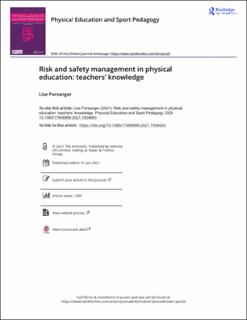| dc.description.abstract | Background
In school-based physical education (PE) programs, teachers’ task to identify, assess, manage and communicate risk and safety and balance these with other pedagogical concerns is complex. Teachers’ knowledge is essential in generating quality PE and their specialized knowledge of risk and safety management (RSM) is crucial for creating safe learning environments and educative opportunities for students. However, studies of teachers’ RSM knowledge seem scarce and particularly studies including teachers’ perspectives.
Purpose
The purpose of this study is to explore how teachers develop their RSM knowledge for PE programs.
Methods
To gain data on teachers’ perspectives on RSM semistructured in-depth interviews were used to generate data. The study involves 17 primary and lower secondary PE teachers from Norway. To emphasize the participants’ voices for empirical sensitivity In-vivo and focused coding were employed in the analysis. These codes comprised a further basis for the generation of categories representing core meaning in the material.
Findings
The results of this study suggest that teachers’ institutional arrangements provide teachers with limited formal RSM training. In PE teacher education (PETE) the preparations of pre-service teachers for the use of RSM approaches might be restricted to selected physical activities according to these teachers. Moreover, due to a lack of resources and training in the teachers’ in-service period they seem compelled to develop an individual approach to and knowledge dimension for RSM. The attention teachers give to RSM in PE is consequently widely differing. As their RSM knowledge is individualized and privatized, personal preferences and experiences from teaching are central in developing teachers’ RSM knowledge. In this environment however, accountability, close calls and accidents might have a critical function for teachers’ conscious development of RSM knowledge.
Conclusions
PE teachers’ RSM knowledge development is embedded within an institutional environment where teaching experience is vital. Teachers’ RSM knowledge may become tacit and bespoke to the teachings of PE with extensive experience. According to the results presented here, beginner teachers might be in a vulnerable position; lacking formal training and teaching experience to deal with risk and safety concerns in PE programs. This study therefore suggests a need for strengthening and widening RSM training in PETE programs for developing and expanding pre-service teachers’ RSM knowledge. Although RSM may be a continuous developmental and learning process, in-service PE teachers also seem to a large extent to be left on their own. It seems therefore equally necessary to support teachers’ continuous professional development and allocating distinct resources for developing teachers’ RSM knowledge in generating quality PE programs. | en_US |

